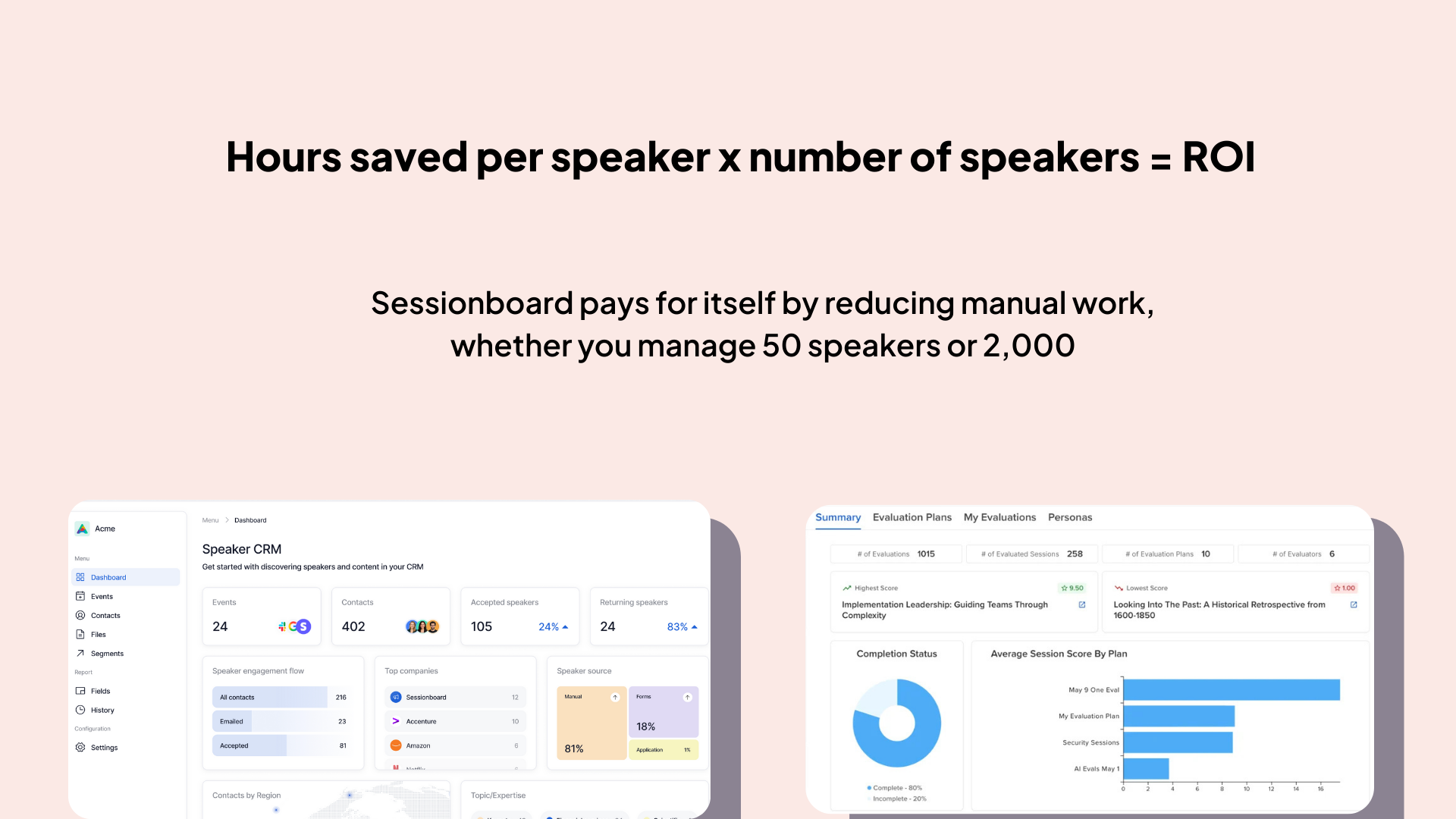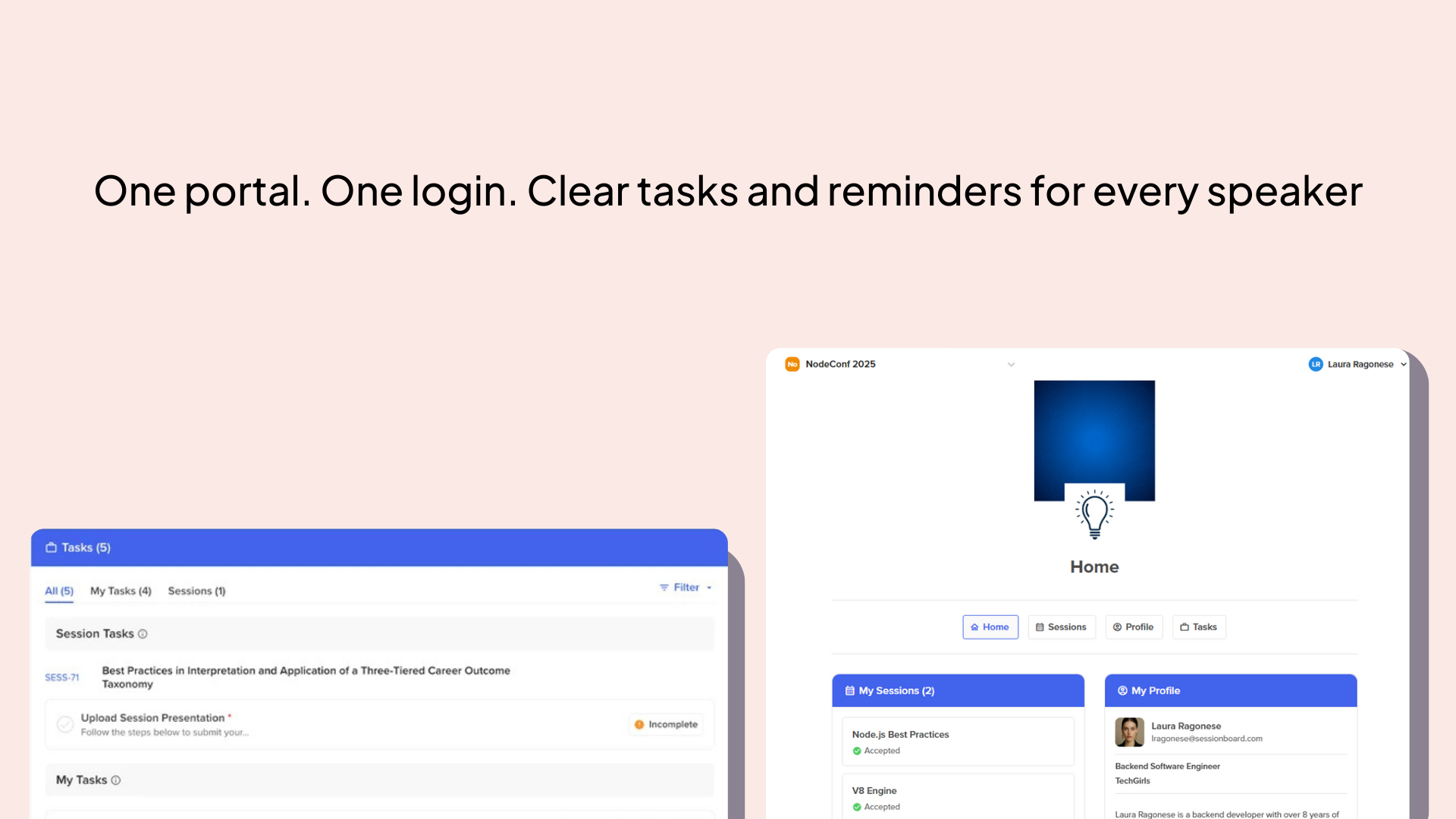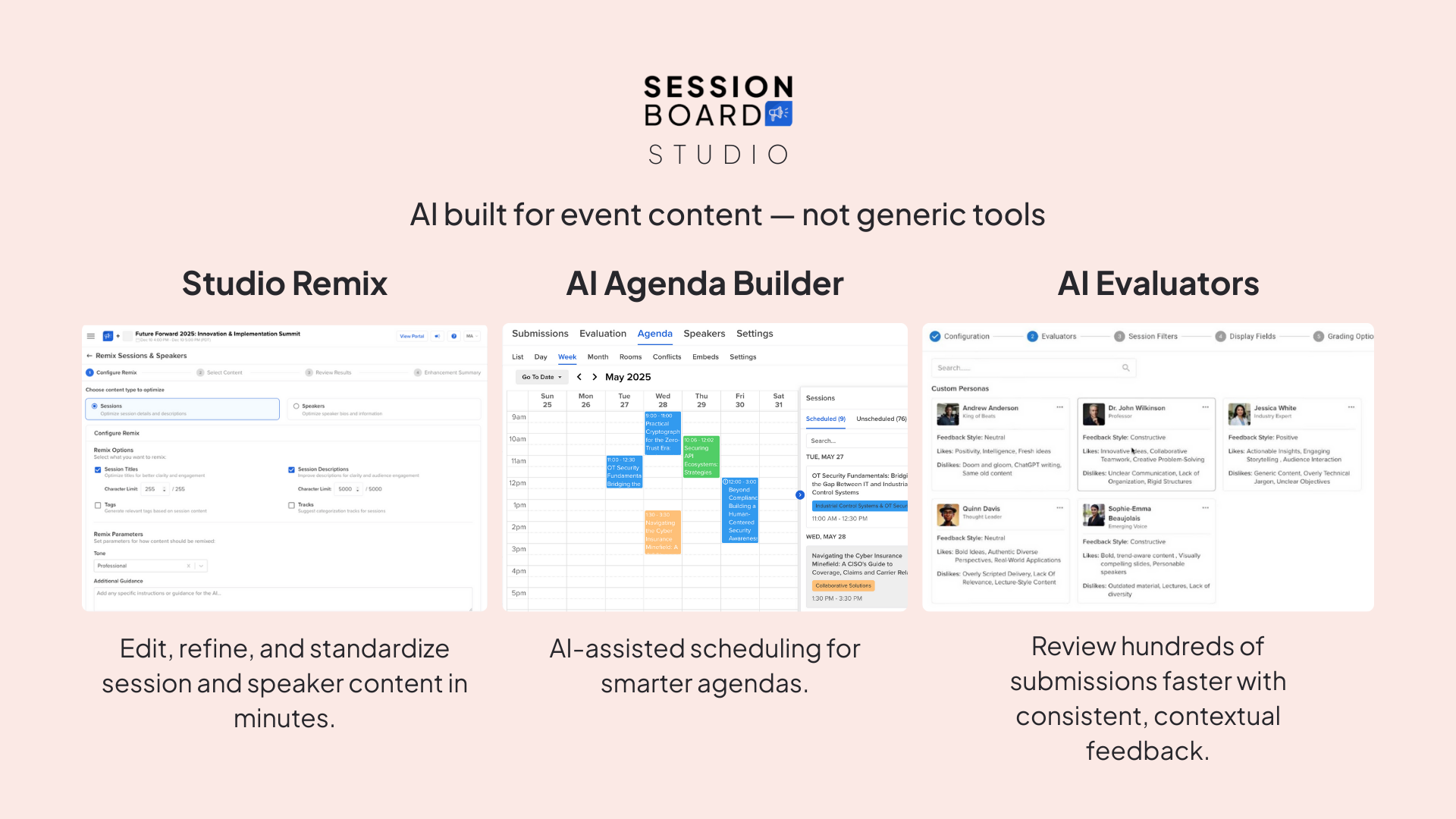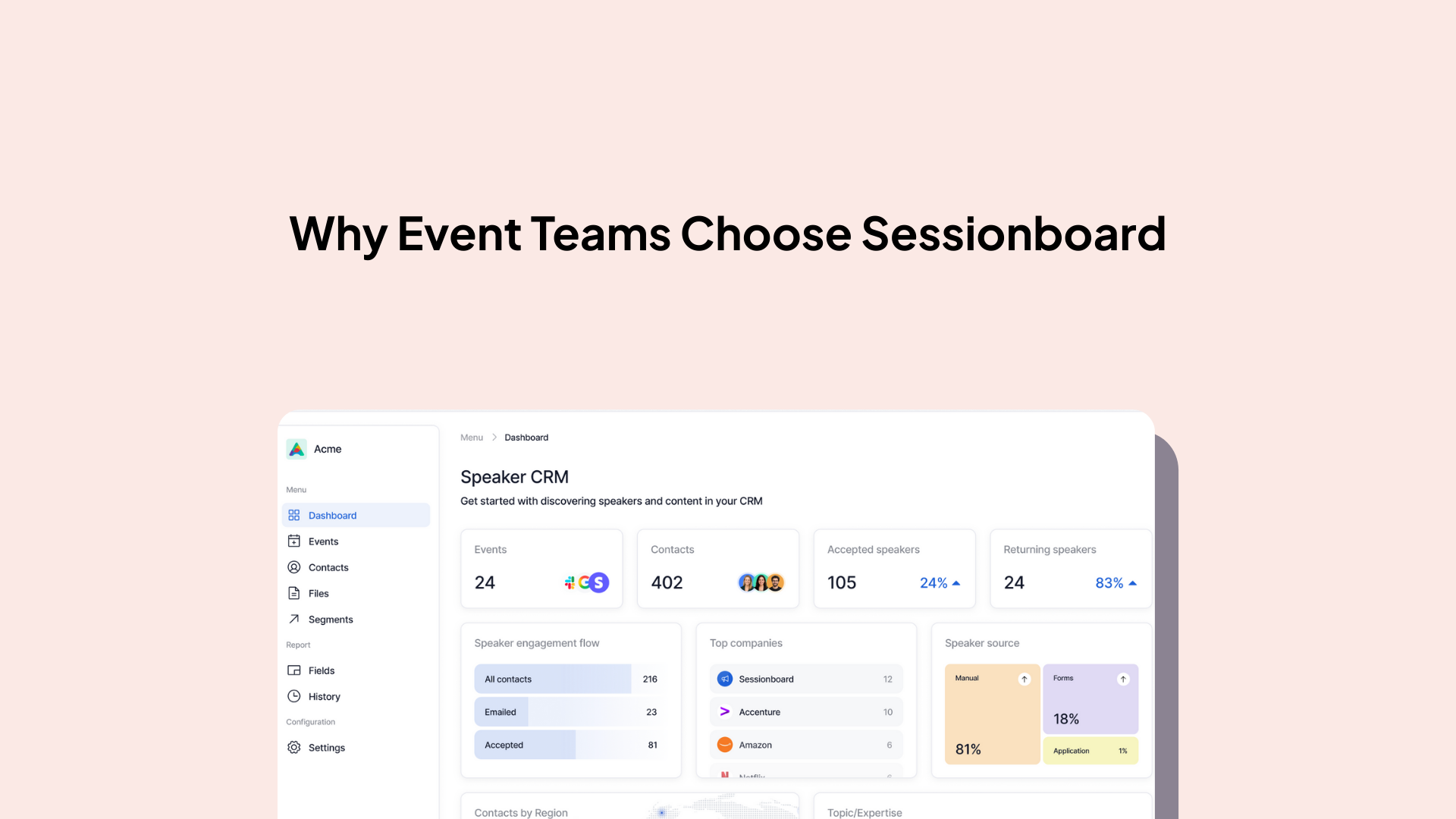Sessionboard Wrapped 2025
Inside the Features, AI, and Workflows Shaping the Future of Event Content


.png)
Every time a new tool enters the conversation, questions and hesitations are bound to come up. We have heard them all, from budget constraints to worries about speaker adoption to the fear of adding yet another platform to an already crowded stack.
The truth is, these concerns are valid. They come from real challenges that event teams deal with every day. That is exactly why we built Sessionboard with those challenges in mind. The platform is designed to address them directly, not ignore them.
And here is the even better news. Event teams who take the leap and implement Sessionboard quickly see that the so-called roadblocks are actually opportunities. What started as hesitation often turns into relief, time saved, and measurable ROI.
In this post, we will look at the top myths we hear most often from first-time buyers and show how event teams using Sessionboard have already proven them wrong.

Reality: Registration platforms are built to capture attendee data, not to manage the hundreds of moving parts that go into speaker and content workflows. Without a dedicated system, teams spend hours chasing bios, decks, and session details across email threads and spreadsheets.
On average, Sessionboard saves 2–3 hours per speaker, per event. That adds up quickly, often covering the cost of the platform within the first event cycle. Instead of adding overhead, Sessionboard reduces it—turning manual effort into measurable ROI.
We also offer flexible packages, so the investment can scale with your team’s budget and event size.
Reality: Registration systems, form builders, and spreadsheets each do their job well, but none of them were designed to handle the complexity of speaker and content workflows. That is why so many teams end up stitching them together with endless email threads, manual updates, and version confusion.
Sessionboard is purpose-built for content. Submission forms, evaluation workflows, speaker portals, and agenda builders are ready to go the moment you log in. Instead of layering task management on top of spreadsheets or forcing tools like Google Forms to do what they were never meant to do, you finally get one home where content flows from submission to publishing.
And because Sessionboard integrates directly with registration systems, you do not create duplicate work. You eliminate it. The result is fewer spreadsheets, fewer reminders, and far more control.
Reality: Event teams are already stretched thin, so the idea of adding another platform can feel overwhelming. That is why Sessionboard was designed for fast adoption and immediate wins. Most teams are up and running after just two or three guided calls with our Customer Success team.
The platform mirrors the way event content already flows—submissions, evaluations, speaker prep, and agendas—so users are not learning a brand-new process, just moving from manual work to structured workflows. And because everything lives in one place, teams quickly see the payoff: fewer emails, fewer status meetings, and more time for higher-value work.
Guru Media Hub is a great example. Their team was able to adopt Sessionboard mid-cycle and immediately reduce the time they were spending chasing speakers for updates. What seemed impossible at first quickly became one of their easiest transitions.
You are never left on your own. Our Customer Success team becomes an extension of your staff, guiding setup, sharing best practices from other events, and helping you show early ROI to your stakeholders. Instead of another tool to manage, Sessionboard feels like gaining extra hands on your team.

Reality: The pressure of an upcoming event makes it feel impossible to change course, but that is exactly when Sessionboard can deliver the most immediate relief. Many of our customers start mid-cycle. We import your existing speaker or submission data, align it with your current process, and get you up and running without disrupting your timelines.
Instead of waiting until “next year” and facing another round of manual emails, spreadsheets, and shared folders, you can see benefits right away. Teams often onboard in a matter of weeks and begin using features like submission tracking, speaker portals, and evaluation dashboards during the same event they signed up for.
And with Studio Remix, our AI content editing assistant, teams can clean up session titles, abstracts, and speaker bios in minutes—even late in the cycle. What used to mean frantic formatting work right before publishing can now be handled quickly and consistently inside the same system.
The result? You do not lose momentum—you gain visibility and control at a point in the cycle where every hour matters. For many teams, onboarding with Sessionboard mid-event has been the difference between barely keeping up and actually getting ahead.
Reality: No one wants to spend weeks untangling data silos or worrying about sync errors. That is why Sessionboard was built to fit seamlessly into your event tech stack. Out of the box, we offer ready-made integrations with leading platforms like Cvent, ON24, Swapcard, and Stova, and we back that up with a robust open API.
Instead of introducing “one more tool to manage,” Sessionboard removes the burden of juggling files, forms, and updates across disconnected systems. It becomes the central hub for speaker and session content while keeping the rest of your stack in sync. The result is less manual work, fewer errors, and a smoother experience for your team and your speakers.
Reality: The speaker experience is often where event platforms fall short, and we take that seriously. With Sessionboard, every speaker gets one simple, branded dashboard where they can see deadlines, tasks, and reminders in a clear, structured way. Instead of juggling endless emails and attachments, everything they need lives in one place.
Adoption is not about forcing speakers into a system—it is about making their lives easier. That is why the portal is designed to feel intuitive from the first login, whether they are updating a profile, uploading a deck, or collaborating with co-presenters. Mobile access makes it even more convenient, so speakers can stay on track no matter where they are.
We recently shared how speaker portals solve one of the biggest pain points in event planning: endless back-and-forth emails for bios, headshots, and files. That same principle applies here. When the process is easier for speakers, adoption follows naturally.
And for your team, the platform does not replace your personal touch. All of your white-glove communications can still flow through Sessionboard, which means you keep the relationship while removing the repetitive follow-ups. The result is happier speakers, fewer missed deadlines, and smoother collaboration for everyone involved.
Reality: The number of speakers does not determine the complexity of managing content. Whether you have 50 speakers or 2000, the same pain points appear: chasing bios, collecting slides, sending reminders, and tracking what is missing.
Smaller teams often see the highest return on investment from Sessionboard because they do not have extra staff to absorb that manual work. Without a tool, one person ends up wearing multiple hats and spending hours in spreadsheets and email. With Sessionboard, reminders go out automatically, updates flow directly into the agenda, and you always know where things stand.
We have seen small associations and lean event teams adopt Sessionboard and quickly realize they were working harder than they needed to. By centralizing speaker and content workflows in one place, they unlocked time to focus on shaping the program and engaging attendees.
Scaling is not about size. It is about efficiency. The sooner you bring structure into your process, the sooner you save time and protect your team from burnout.

Reality: Sessionboard is enterprise-ready, with role-based permissions, SSO, and encryption that keep sensitive information secure. For full details, see our Security Policy.
Reality: Abstract-heavy events do bring a different level of complexity, and we treat them accordingly. With Sessionboard, you are not forced into a one-size-fits-all model. We work with you to shape an approach that makes sense for your event. The platform is built to handle high volumes of submissions, complex authorship structures, and layered permissions, while still giving your team control and visibility. Instead of bending your process to fit rigid tools, you get flexibility and structure designed to keep even the most complex abstract workflows organized.
Reality: We hear this often, and it is a fair concern. Many event teams have been let down by legacy systems that were rigid, outdated, and hard to use. Those platforms often created more work instead of solving real problems, which makes it natural to be cautious about adopting something new.
Sessionboard was built to change that experience. It is designed with modern event workflows in mind, with flexible integrations that connect to the tools you already use, and a product roadmap shaped directly by customer feedback. We focus on usability and partnership, so you are not just handed a login and left on your own. Our team works closely with you to ensure the platform fits your process and scales as your needs grow.
The result is that teams who once felt burned by past tools now describe Sessionboard as both a breath of fresh air and a trusted partner. Instead of being locked into someone else’s rigid structure, you gain a solution that adapts to your event and evolves alongside your strategy.

On the flip side, here are ten self-reflective reasons event professionals tell us they choose Sessionboard:
Objections are not a bad sign. They mean your team is asking the right questions. Our job is to help you see what is possible when you stop wrestling with workarounds and start managing content in a purpose-built way.
If you are preparing for internal conversations about tools, our free RFP template can help guide that process. It is designed to surface the questions that matter most so you can compare platforms with confidence.
And if you are curious how Sessionboard could fit your workflow, let’s talk.
Every time a new tool enters the conversation, questions and hesitations are bound to come up. We have heard them all, from budget constraints to worries about speaker adoption to the fear of adding yet another platform to an already crowded stack.
The truth is, these concerns are valid. They come from real challenges that event teams deal with every day. That is exactly why we built Sessionboard with those challenges in mind. The platform is designed to address them directly, not ignore them.
And here is the even better news. Event teams who take the leap and implement Sessionboard quickly see that the so-called roadblocks are actually opportunities. What started as hesitation often turns into relief, time saved, and measurable ROI.
In this post, we will look at the top myths we hear most often from first-time buyers and show how event teams using Sessionboard have already proven them wrong.

Reality: Registration platforms are built to capture attendee data, not to manage the hundreds of moving parts that go into speaker and content workflows. Without a dedicated system, teams spend hours chasing bios, decks, and session details across email threads and spreadsheets.
On average, Sessionboard saves 2–3 hours per speaker, per event. That adds up quickly, often covering the cost of the platform within the first event cycle. Instead of adding overhead, Sessionboard reduces it—turning manual effort into measurable ROI.
We also offer flexible packages, so the investment can scale with your team’s budget and event size.
Reality: Registration systems, form builders, and spreadsheets each do their job well, but none of them were designed to handle the complexity of speaker and content workflows. That is why so many teams end up stitching them together with endless email threads, manual updates, and version confusion.
Sessionboard is purpose-built for content. Submission forms, evaluation workflows, speaker portals, and agenda builders are ready to go the moment you log in. Instead of layering task management on top of spreadsheets or forcing tools like Google Forms to do what they were never meant to do, you finally get one home where content flows from submission to publishing.
And because Sessionboard integrates directly with registration systems, you do not create duplicate work. You eliminate it. The result is fewer spreadsheets, fewer reminders, and far more control.
Reality: Event teams are already stretched thin, so the idea of adding another platform can feel overwhelming. That is why Sessionboard was designed for fast adoption and immediate wins. Most teams are up and running after just two or three guided calls with our Customer Success team.
The platform mirrors the way event content already flows—submissions, evaluations, speaker prep, and agendas—so users are not learning a brand-new process, just moving from manual work to structured workflows. And because everything lives in one place, teams quickly see the payoff: fewer emails, fewer status meetings, and more time for higher-value work.
Guru Media Hub is a great example. Their team was able to adopt Sessionboard mid-cycle and immediately reduce the time they were spending chasing speakers for updates. What seemed impossible at first quickly became one of their easiest transitions.
You are never left on your own. Our Customer Success team becomes an extension of your staff, guiding setup, sharing best practices from other events, and helping you show early ROI to your stakeholders. Instead of another tool to manage, Sessionboard feels like gaining extra hands on your team.

Reality: The pressure of an upcoming event makes it feel impossible to change course, but that is exactly when Sessionboard can deliver the most immediate relief. Many of our customers start mid-cycle. We import your existing speaker or submission data, align it with your current process, and get you up and running without disrupting your timelines.
Instead of waiting until “next year” and facing another round of manual emails, spreadsheets, and shared folders, you can see benefits right away. Teams often onboard in a matter of weeks and begin using features like submission tracking, speaker portals, and evaluation dashboards during the same event they signed up for.
And with Studio Remix, our AI content editing assistant, teams can clean up session titles, abstracts, and speaker bios in minutes—even late in the cycle. What used to mean frantic formatting work right before publishing can now be handled quickly and consistently inside the same system.
The result? You do not lose momentum—you gain visibility and control at a point in the cycle where every hour matters. For many teams, onboarding with Sessionboard mid-event has been the difference between barely keeping up and actually getting ahead.
Reality: No one wants to spend weeks untangling data silos or worrying about sync errors. That is why Sessionboard was built to fit seamlessly into your event tech stack. Out of the box, we offer ready-made integrations with leading platforms like Cvent, ON24, Swapcard, and Stova, and we back that up with a robust open API.
Instead of introducing “one more tool to manage,” Sessionboard removes the burden of juggling files, forms, and updates across disconnected systems. It becomes the central hub for speaker and session content while keeping the rest of your stack in sync. The result is less manual work, fewer errors, and a smoother experience for your team and your speakers.
Reality: The speaker experience is often where event platforms fall short, and we take that seriously. With Sessionboard, every speaker gets one simple, branded dashboard where they can see deadlines, tasks, and reminders in a clear, structured way. Instead of juggling endless emails and attachments, everything they need lives in one place.
Adoption is not about forcing speakers into a system—it is about making their lives easier. That is why the portal is designed to feel intuitive from the first login, whether they are updating a profile, uploading a deck, or collaborating with co-presenters. Mobile access makes it even more convenient, so speakers can stay on track no matter where they are.
We recently shared how speaker portals solve one of the biggest pain points in event planning: endless back-and-forth emails for bios, headshots, and files. That same principle applies here. When the process is easier for speakers, adoption follows naturally.
And for your team, the platform does not replace your personal touch. All of your white-glove communications can still flow through Sessionboard, which means you keep the relationship while removing the repetitive follow-ups. The result is happier speakers, fewer missed deadlines, and smoother collaboration for everyone involved.
Reality: The number of speakers does not determine the complexity of managing content. Whether you have 50 speakers or 2000, the same pain points appear: chasing bios, collecting slides, sending reminders, and tracking what is missing.
Smaller teams often see the highest return on investment from Sessionboard because they do not have extra staff to absorb that manual work. Without a tool, one person ends up wearing multiple hats and spending hours in spreadsheets and email. With Sessionboard, reminders go out automatically, updates flow directly into the agenda, and you always know where things stand.
We have seen small associations and lean event teams adopt Sessionboard and quickly realize they were working harder than they needed to. By centralizing speaker and content workflows in one place, they unlocked time to focus on shaping the program and engaging attendees.
Scaling is not about size. It is about efficiency. The sooner you bring structure into your process, the sooner you save time and protect your team from burnout.

Reality: Sessionboard is enterprise-ready, with role-based permissions, SSO, and encryption that keep sensitive information secure. For full details, see our Security Policy.
Reality: Abstract-heavy events do bring a different level of complexity, and we treat them accordingly. With Sessionboard, you are not forced into a one-size-fits-all model. We work with you to shape an approach that makes sense for your event. The platform is built to handle high volumes of submissions, complex authorship structures, and layered permissions, while still giving your team control and visibility. Instead of bending your process to fit rigid tools, you get flexibility and structure designed to keep even the most complex abstract workflows organized.
Reality: We hear this often, and it is a fair concern. Many event teams have been let down by legacy systems that were rigid, outdated, and hard to use. Those platforms often created more work instead of solving real problems, which makes it natural to be cautious about adopting something new.
Sessionboard was built to change that experience. It is designed with modern event workflows in mind, with flexible integrations that connect to the tools you already use, and a product roadmap shaped directly by customer feedback. We focus on usability and partnership, so you are not just handed a login and left on your own. Our team works closely with you to ensure the platform fits your process and scales as your needs grow.
The result is that teams who once felt burned by past tools now describe Sessionboard as both a breath of fresh air and a trusted partner. Instead of being locked into someone else’s rigid structure, you gain a solution that adapts to your event and evolves alongside your strategy.

On the flip side, here are ten self-reflective reasons event professionals tell us they choose Sessionboard:
Objections are not a bad sign. They mean your team is asking the right questions. Our job is to help you see what is possible when you stop wrestling with workarounds and start managing content in a purpose-built way.
If you are preparing for internal conversations about tools, our free RFP template can help guide that process. It is designed to surface the questions that matter most so you can compare platforms with confidence.
And if you are curious how Sessionboard could fit your workflow, let’s talk.

Stay up to date with our latest news
See how real teams simplify speaker management, scale content operations, and run smoother events with Sessionboard.